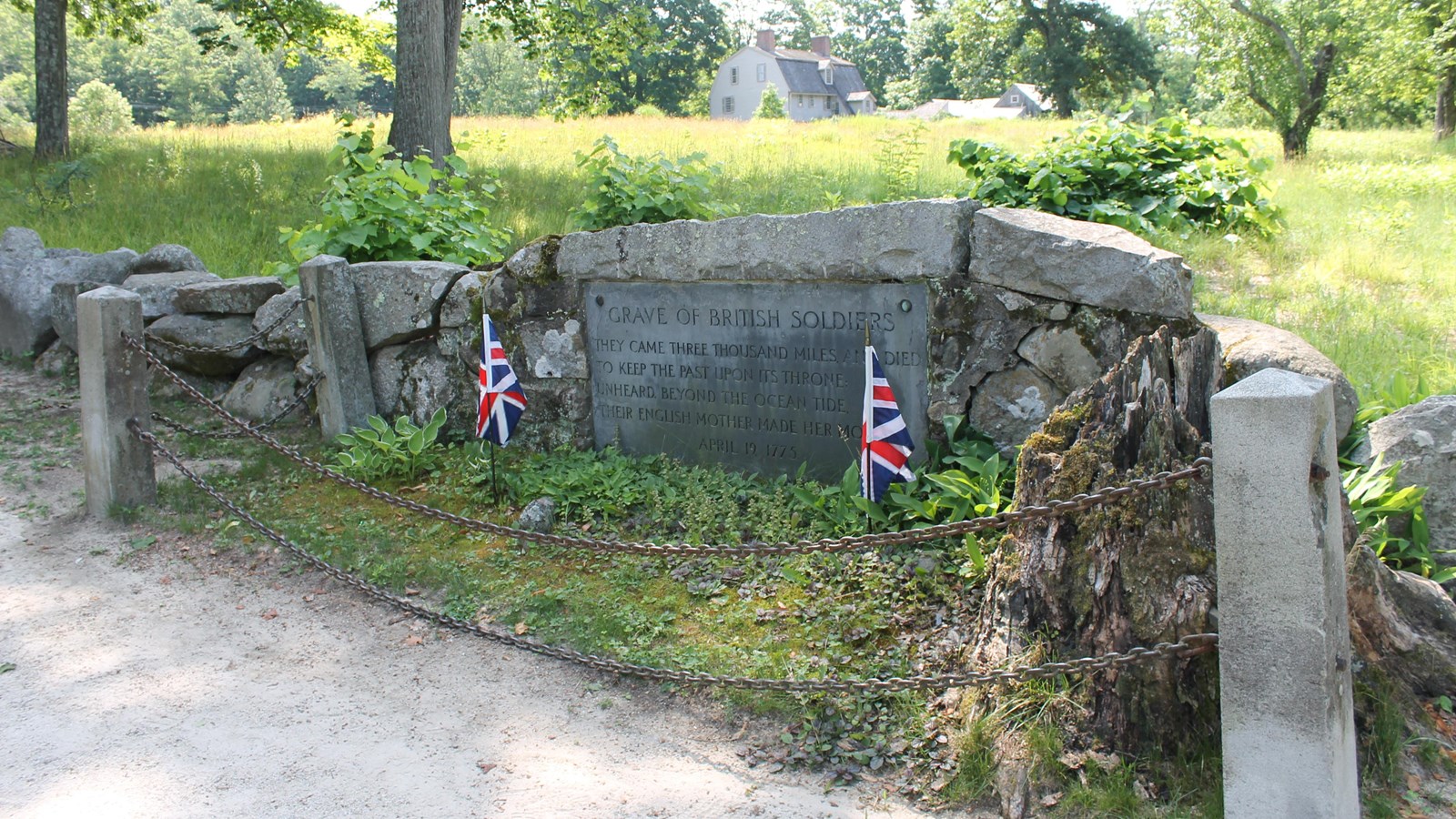Last updated: January 16, 2023
Place
Grave of British Soldiers at the North Bridge

NPS Photo
Accessible Sites, Historical/Interpretive Information/Exhibits, Pets Allowed, Scenic View/Photo Spot, Wheelchair Accessible
THE GRAVE OF BRITISH SOLDIERS
"They came three thousand miles, and died, To keep the Past upon its throne; Unheard, beyond the ocean tide, Their English mother made her moan."
For Centuries Dead, Ye Are Not Lost
On the morning of April 19, 1775 , ninety-six British soldiers from the 4th, 10th, and 43rd Regiments of Foot took position near the North Bridge in Concord, Massachusetts. At this narrow river crossing the soldiers guarded access to the town while their comrades searched for illegal weapons and supplies hidden in the surrounding farms. Only yards away, nearly 400 colonial militia gathered on a hilltop to observe the regulars. When a plume of dark smoke appeared from the center of Concord those militia decided to advance for fear the regulars were burning their homes. As one British officer recalled, "We had not been long in this situation when we saw a large body of men drawn up with the greatest regularity and approach'd us seemingly with an intent to attack…" Outnumbered, the regulars retreated back across the river, some attempting to rip boards from the bridge before the militia could cross.
In panicked ranks the British light infantry fired two warning shots before deliberately aiming into the oncoming militia. The ragged volley killed Militia Captain Isaac Davis and private Abner Hosmer instantly. Major. John Buttrick, leading the advance, called out to the militia, "Fire, fellow soldiers, for god's sake fire!" In the hail of musketry that followed two British regulars fell dead, a third mortally wounded, and nine additional men injured. Shortly thereafter the light infantry retreated in confusion back toward Concord, leaving their dead where they fell.
Research of muster rolls from the 4th Regiment of Foot indicates Thomas Smith, Patrick Gray, and James Hall, as those possibly killed near the North Bridge. Unfortunately, records of the day are scarce, and it is difficult to know for certain. In recent years, historical scholarship indicates James Hall may have survived the ordeal at the Bridge.
Controversy at the bridge
Minutes after fighting erupted at the North Bridge, additional British soldiers returning from searching Col. Barret's farm marched down the causeway and crossed the river unopposed. As they approached the opposite bank they saw two of their fellow soldiers laying dead and least five men attested they saw one of their comrades with "the skin over his Eye's cut and also the top part of his ears cut off…"
Upon returning to the main column in town, those witnesses spread word that the Militia were scalping the wounded. This rumor later grew into one highlighting the "cruelty and barbarity of the rebels," and eventually claimed, the wounded soldiers were "…afterwards scalp'd their Eyes goug'd their Noses and Ears cut off..."
With emotions running high after the fight, both British Regulars and Colonial Militia delivered sworn testimony about the events at the bridge. From this we learn that shortly after the fight two men, Zerchariah Brown and Thomas Davis, "buried the dead bodies of the King's troops that were killed at the North-Bridge in Concord, on the nineteenth day of April, 1775, where the action first began, and that neither of those persons were scalped, nor their ears cut off, as has been represented."
For decades, interested parties argued the facts of the engagement. Eventually, local sources claimed that a young militia solider named Ami White had dispatched the wounded soldier with a hatchet blow to the skull.
The Grave Markers
In Mosses from the Old Manse, famed author Nathanial Hawthorne wrote, "A humbler token of the fight, yet a more interesting one than the granite obelisk, may be seen close under the stone-wall, which separates the battle-ground from the precincts of the parsonage. It is the grave-marked by a small, moss-grown fragment of stone at the head, and another at the foot- the grave of two British soldiers, who were slain in the skirmish. " Today the remains of those small grave markers rest on the northern side of the stonewall.
In 1870, Concord's superintendent of public grounds erected "a small stone slab, with a suitable inscription," in preparation for the centennial anniversary, as the two small stones marking the grave were "neither seen nor understood by strangers." The stone slab inscribed "Grave of British Soldiers" cost the town $25. In 1877, the town placed additional granite post and chain fencing around the gravesite and in 1910 added an additional marker adorned with a section of James Russel Lowell's poem "Lines." Lowell wrote the poem after visiting the gravesite with Nathanial Hawthorne in 1849.
The grave site today is cared for by the National Park Service in partnership with the Town of Concord. Every April, on the annual commemoration of the battle, the grave is newly decorated in a moving ceremony by British reenactors.
Kehoe, Vincent J-R. 1974. "We were there!": April 19th 1775. [Chelmsford, Mass.]: [The author].
James Russell Lowell, "Lines suggested by the graves of two English Soldiers on Concord Battleground" 1849
Hear Nathanial Hawthorne's Description of the North Bridge Battleground here.
